
Who Can He Be?
Forensic Evidence
Forensic science is an important tool used by justice systems all over the world to help analyse evidence found at a crime scene. A bloodstained cloth found at a murder scene can reveal a great deal about the crime and the cause of death, which often helps to establish the guilt or innocence of a suspect. Although the death of Jesus Christ took place two thousand years ago, the same techniques can be applied to study the Shroud. These studies have produced some remarkable findings which tell us a great deal about the cloth and the body that had been wrapped inside it.
Forensic Analysis of the Cloth
There are several textile-related characteristics of the Shroud that are entirely consistent with it having a first century, middle eastern origin.
The dimensions of the cloth are 4.4 metres by 1.1 metres, which corresponds to 8 by 2 Assyrian cubits, the unit of measure that was used in that region during the time of Christ.
Most Egyptian linen yarn at that time was spun anti-clockwise which produces a ‘S’ twist but the Shroud yarn was spun clockwise, producing a ‘Z’ twist, which was typical of textiles from the Syro-Palestinian region during the first century.
According to textile expert Mechthild Flury-Lemberg, the seam stitching used to attach a side-strip to the main body of the Shroud is unusual and closely resembles Jewish textiles found at Masada, the Jewish fortress which was overthrown by the Romans in 73 AD.
Some cotton fibres have been found in the linen yarn of the Shroud. The small quantities suggests that they are stray fibres from earlier work with cotton by the weaver who produced the Shroud. The cotton fibres have been identified as Gossypium Herbaceum, a type of cotton native to the Middle East. However, no wool fibres have been found, which is to be expected if the textile workers were observing the Mosaic law of the Jews, which prohibits the mixing of linen and wool.
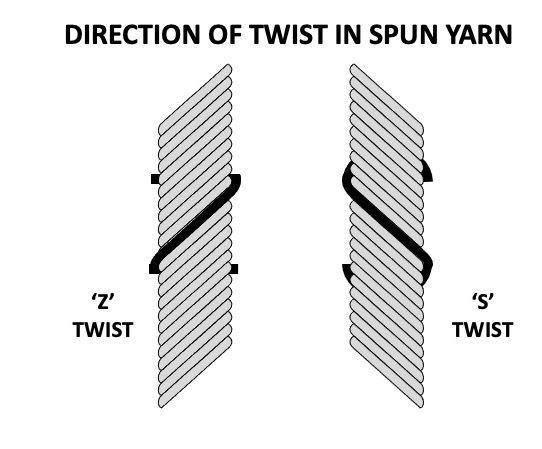
Forensic Analysis of the Blood Evidence

© Barrie M. Schwortz Collection, STERA Inc.
Shroud with highlighted bloodstains
From a forensic viewpoint, all the blood marks depicted were in agreement with the historic descriptions of Christ's crucifixion:
- The presence of flog marks.
- The blood flow on the arms indicates they were elevated and in an extended position.
- The presence of what appears to be a lance wound.
- Marks on the head that could be attributed to a crown of thorns.
- Wounds on the wrists and feet consistent with being nailed to the cross.
The nail wounds on the wrist have been shown to be forensically correct. Pierre Barbet’s experiments with cadavers showed that nails driven through the palms as shown in most artistic renditions of a crucifixion will not support the weight of a suspended human body.
Blood images also appear thickened on the edges which is consistent with them being formed from clotted blood rather than fresh flowing blood. There are also visible serum rings, which would be expected due to serum being exuded from the blood as scabs are formed. The shape of the stain on the wrist and the direction of flows of blood on the forearms indicates that the arms were approximately 65 degrees above the horizontal at the time of the blood flow. The divergence of the streams suggests that two positions were adopted with an angle difference of about 10 degrees. This indicates that the victim elevated his body by pushing up from the feet to relieve the pressure on the chest and then changing position to take the full body weight on the wrists.
Over the years, several highly qualified medical scientists have performed detailed examinations of the Shroud including:
- Dr. Yves Delage, Professor of Comparative Anatomy, Paris
- Dr. Paul Vignon, Professor of Biology, Paris
- Dr. Pierre Barbet, Professor of Anatomy, Paris
- Dr. Robert Bucklin, MD, Forensic Examiner, Los Angeles
- Dr. Frederick Zugibe, Chief Medical Examiner, New York
- Dr. Pierluigi Baima-Bollone, Chief of Forensic Medicine, Turin
They all reached a common conclusion: the Shroud had wrapped the body of a crucified man and the bloodstains and other markings are consistent with the Gospel descriptions of the torture and crucifixion of Jesus Christ.
Chemical Analysis of the Blood
A chemical analysis of the blood deposits on the Shroud confirmed the presence of typical blood constituents such as protein, hemin, bilirubin, and albumin. In contrast, no mercury compounds or iron oxides were found which would typically be expected had these marks been made by an artist. The blood also contained both type A and type B antigens, characteristic of blood group AB.
Although blood stains usually darken over time, traumatic shock of the type experienced after flogging and crucifixion causes red blood cells to rupture. The released haemoglobin is degraded by the liver to form bilirubin, which causes the blood stains to retain a reddish-orange hue, matching the appearance of the blood stains on the Shroud. The chemical evidence of the Shroud blood indicates that not only was it human blood, but that it was shed by someone who suffered a traumatic death.
How the Shroud was wrapped around the body
The imprint on the burial cloth represents the body of an adult male, approximate 5 feet eleven inches in height (1.8 metres) and weighing between 160 to 170 pounds (72.5 to 77.1 kilograms). The general appearance of the body indicates stiffness suggesting that rigor mortis is present.
There is a three inch (eight centimetre) wide, full length linen strip sewn onto the side of the Shroud with a clearly visible seam. When this is photographed with the Shroud lit from behind, it reveals banding caused by inconsistencies in the yarn used to weave the Shroud. The banding marks on both sides of the seam match exactly, which indicates that the so-called side strip had been part of the cloth when it was woven but had been cut out and later stitched back into its original position.
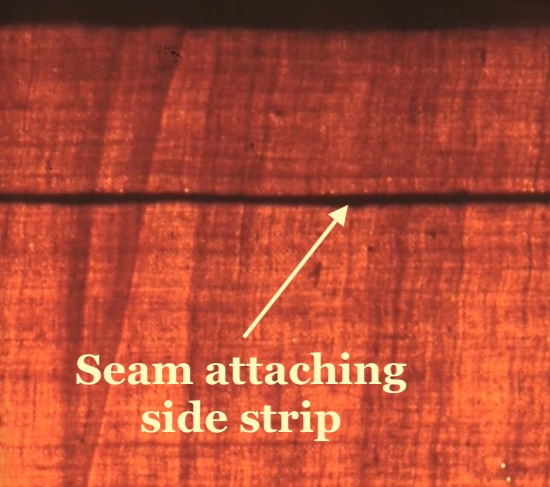
Photograph showing the banding which is continuous across the seam
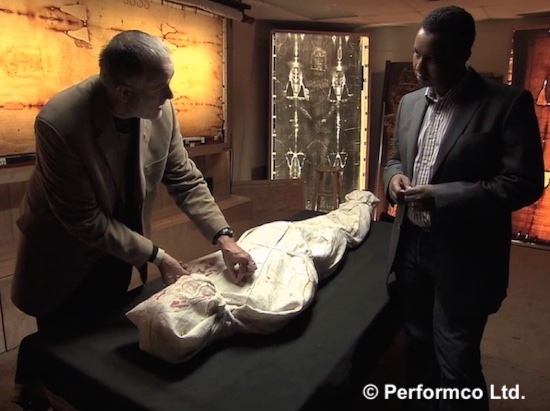
John Jackson demonstrating how the side strip was used to wrap the Shroud
Dr. John Jackson has experimented with a life-sized model of the body and a replica of the Shroud to see whether the bloodstains on the cloth align with the wounds around the head, hands, side and feet. He believes that after the body had been placed in the Shroud, one end of the strip was tied tightly around the feet, before wrapping the strip around the knees to keep the legs together, then around the torso and finally around the head before tying the other end of the strip beneath the chin.
When the body is wrapped this way, the bloodstains on the cloth are perfectly aligned with the wounds and the image aligns with the body’s shape and position. This use of the side strip also explains a passage in the Gospel of John which describes what he and the apostle Peter found when they entered the empty tomb following the resurrection:
Then cometh Simon Peter following him, and went into the sepulchre, and seeth the linen clothes lie, and the napkin, that was about his head, not lying with the linen clothes, but wrapped together in a place by itself. Gospel of John, 20: 6-7
The reference to linen clothes, rather than a linen cloth, has caused some bible scholars to question whether John was referring to the Shroud. However, if Dr. Jackson’s side strip explanation is correct, it accounts for why the apostle referred to the linen clothes when he saw the Shroud lying with the side strip.
Forensic Analysis of Dust Deposits
Pollen Deposits
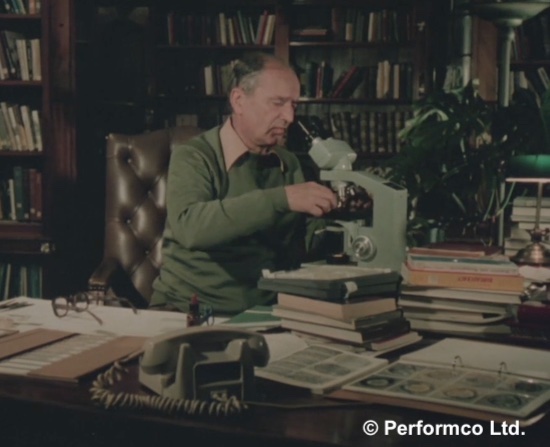
Max Frei
Max Frei, a criminalist who specialised in forensic analysis, examined the Shroud on two occasions, in 1973 and 1978, during which he pressed adhesive tapes against the surface of the Shroud to extract surface dust and other deposits. He found pollen grains when he analysed the dust deposits under a microscope and was subsequently able to identify the species of plant that these were from. Some of these species were plants native to France or Italy but approximately half of them were not found in Europe. There were pollen grains from species that were specific to areas of Palestine, including the Dead Sea area, as well as from plants that are only found in the Anatolia region of Turkey, which is where the city of Urfa, formerly Edessa, is located. He also found pollen from species found only in the area of Istanbul, formerly Constantinople.
The pollen evidence supports the claims of some historians that prior to its arrival in Europe, the Shroud had spent periods of time in Judea, Edessa and Constantinople.
Mineral Deposits
Some of the surface dust samples that had been collected using sticky tape were analysed by Joseph Kohlbeck, an optical crystallographer. After discovering some limestone particles amongst the Shroud's fibres, he visited Jerusalem in order to obtain samples from the limestone of the ancient rock-cut tombs to see if there might be any kind of match between the characteristics of the Jerusalem limestone and the particles found on the Shroud. Both had a crystalline structure that indicated an uncommon form of limestone known as Travertine Aragonite and they both contained small quantities of iron and strontium, but not lead, which was another unusual similarity.
Dr. Ricardo Levi-Setti of the University of Chicago took this analysis a step further by putting both Shroud and Jerusalem dust samples through his high-resolution scanning ion microprobe. This confirmed that the samples were an unusually close match.
There were high concentrations of this dust found around the foot area of the Shroud but some was also found in the areas corresponding to the tip of the nose and the left knee. This is consistent with the Christian tradition of Jesus walking barefoot carrying a cross and falling under its weight.
The Shroud has also been shown to contain traces of aloe and myrrh, which are substances associated with traditional Jewish burial practice during the first century.
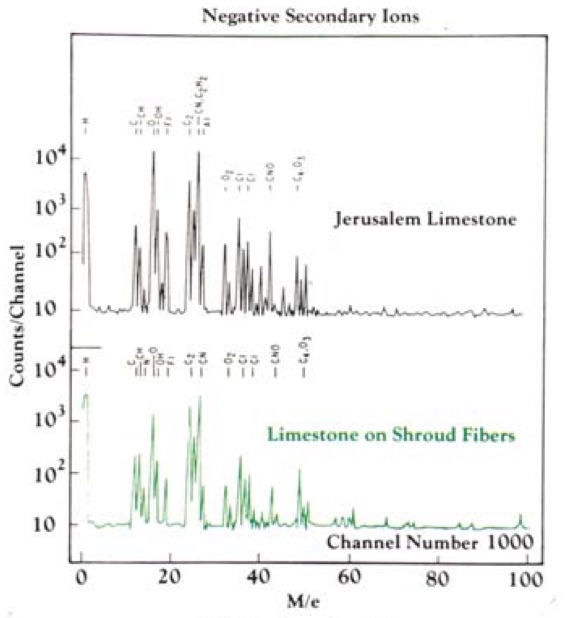
Spectra produced by limestone found in Jerusalem and limestone dust extracted from the Shroud
Performco Ltd. Town Hall, Penn Road, Beaconsfield, Bucks HP9 2PP
Copyright © Performco Ltd.